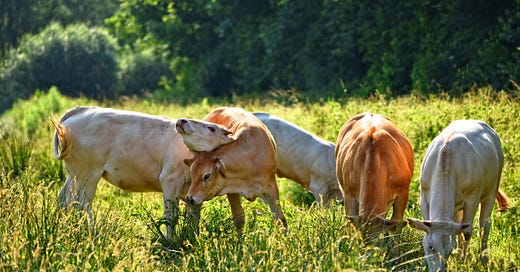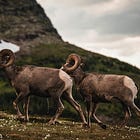You are receiving this because you have subscribed to Daniel Firth Griffith’s, or Robinia Institute’s, or The Wildland’s email newsletter or Substack, which are, today, one and the same. Welcome!
If you enjoy this content, if you find it meaningful to you, we encourage you to become a paid member for $3/mo! With a paid subscription, you get access to all of my four of my previously published and award-winning books (digital and audiobook versions) and so, so much more! It may be a cup of coffee for you, but it is the nourishment that keeps up alive, and we are so very thankful!
This chapter of Stagtine, my latest book that we are dripping here on The Wildland Chronicles, is provided for all PAID members. BUT TODAY, this chapter is given to you for free.
To view a full (slowly released) Table of Contents to Stagtine, my latest book made available to you all in both paperback, digital, and audiobook formats, click here!
You can also purchase all the versions of Stagtine on Amazon.
To read the previous chapter:
That morning’s revelations overpowered our purely intellectual paradigms, a sunrise cresting over a once obscured valley.
The landscape was at work to resolve its sulfur deficiencies. That much the yellow wildflowers and their yellowing grasses well knew. But Nancy was locked in place, she had no anam cara, no soul friend.
The release of breeding was the first step of remediation. Paddy showed us that. Releasing the herd from our management’s control and progressive penchants came next.
Later that afternoon we changed the name of the farm from Timshel Farm to Timshel Wildland.
“What is a wild land?” Morgan asked.
“Wildland as one word, I think. Wild is not an adjective. It is her,” I said, my arm pointing out the window, hoping a squirrel in the nearby walnuts would pick it up, be listening, would care.
“Isn’t that just giving up? Like, we now just do nothing and release everyone?”
“I reckon we have to release ourselves first.”
. . .
Rewilding is many things to many people. For our purposes, it is that which holds life, wildly and autonomously. Many “rewilding projects” begin by importing once-native species. Others commence by erecting ten foot tall game fences to restrict what comes in and what goes out. Even others begin by herbiciding everything to start fresh—removing native plants and their peoples.
Nancy had other plans. She invited us into relationship: to run with her, to accept the basic, imperfect conditions as they are, simply, openly, honestly, as holders for all of life to imbue with its colors, songs, vibrations, sounds, communities, forms, feelings, and energies. Then, from that humble and slowly-filling place, she invited us to accept our role as conversationalists, partners, co-creators—Earthlings in the truest sense. Inseparable from Earth, we are life. When we learn to run with them, we accept the equal extension of responsibility with our two and four legged cousins for the future of the world.
Leave your subduing at the door.
To run with them is forgoing, to some large degree, the visions we have—regardless of our desires. When you run behind a herd, you can steer them, push them in this direction or that. When you run in front of them, you can manage their speeds. But, when you run with them, you waive all of this goodbye, your control, your visions for the world, your mastery over the outcomes, and simply become what you already were: them, us, Earth and its Earthling.
Rewilding and running with them, in these early years, also allowed us insight into a new paradigm with new questions. When making decisions, we began asking: what is the framework that allows us to ask this question? And then, once determined, asking: is this action defensible given this framework?
For instance, we as a modern and groundless people strive to heal the climate. What is the framework that allows us to desire this? Our modern abilities to do so, of course: to affect the weather through strategically polluting it, to harness hydroelectric power and solar energy by blocking rivers and cutting down forests, to utilize fossil fuels to plant crops to make fossil fuels, to mine metals from mountains for industrial manufacturing to heal eroding hillsides, to produce tractors to plant biodiversity, and so on. Our ability to heal the climate comes from our ability to destroy it. Are we comfortable with this ability? Are you? Is attempting to save the climate an action that is defensible? In other words: is saving the climate worth destroying the climate? No seriously, I am asking...for a friend.
To run with them is the relearning of being human once more, one species amidst the great, rhythmic, and sometimes painful melodies of Earth. It is letting go but not giving up. It is releasing hope in order to find it again. It is, like smoke and exhaled breath, about life in the fullest sense and not life that is full of things. It is letting go by diving deeper, by stepping into. It is also about rediscovering the wild not as a place that holds our wonder or a place that holds our more primitive and less developed but happier lives. But a place that is our wonder, that is our place, that is our lives, but not owned by us.
If this is hard for you, know that it is and has been awfully hard for us. We drink from the same poisoned chalice. We live in service to the same machine that takes industrial capitalism for granted and Earth as resource as its guarantee. That, unlike the wind’s wailing and the torrent’s tears, this chalice, this machine grinds not the landscape but the roots of its peoples. And it is gaining ground.
We early realized that, while many rewilding projects existed around the world, they all began with moving companies—they work to remove unwanted animals, people, and nature’s actual chaos and then work to import native species to grow and run about within their prison yards of exclusion fences. To heal the rivers, they buy beavers. To heal the beavers, they buy rivers. To heal the grasslands, they bring in ancient breeds of cattle that look wilder than the ones we have today. But these ancient bovines bawl like everyone else and come in modern trailers and they come ready to be told where to go. A global phenomenon, rewilding is about wild species and not about species that grow wild together.
While these projects may have their worth, we decided that our path would be led by what we had: we would run with Nancy and we would all grow wild together. We would learn from them and they would learn from us. It would be a process, a journey of letting go, a progression of dismission not of species but masters, a step by step becoming of true relationship—rewilding is not a thing but a process. They chew the cud, we chew the fat, and we all grow wild together.
Keep reading with a 7-day free trial
Subscribe to Unshod to keep reading this post and get 7 days of free access to the full post archives.






